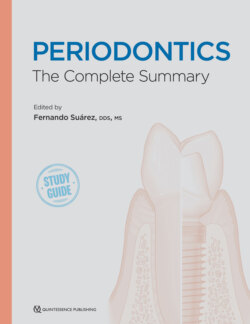Читать книгу Periodontics - Fernando Suarez - Страница 39
На сайте Литреса книга снята с продажи.
2017 WORLD WORKSHOP ON THE CLASSIfiCATION OF PERIODONTAL AND PERI-IMPLANT DISEASES AND CONDITIONS
ОглавлениеIn order to update the 1999 classification of periodontal diseases and conditions,39 an organizing committee from the American Academy of Periodontology (AAP) and the European Federation of Periodontology (EFP) commissioned the world workshop that was held in Chicago on November 9 to 11, 2017.38 The world workshop included expert participants in the field of periodontology and implant dentistry from around the world. The scope of the 2017 world workshop was to align and update the classification scheme to the current understanding of periodontal and peri-implant diseases and conditions. Therefore, in addition to updating the 1999 classification of periodontal diseases and conditions, this was also the first world consensus to develop a classification scheme for peri-implant diseases and conditions.38
A brief classification scheme for the 2017 world workshop is presented in Box 2-5,38 and major changes to the 1999 classification include the following40:
BOX 2-5 2017 World Workshop on the Classification of Periodontal and Peri-implant Diseases and Conditions38
| Periodontal health, gingival diseases/conditionsPeriodontal health and gingival healthClinical gingival health on an intact periodontiumClinical gingival health on a reduced periodontiumStable periodontitis patientNon-periodontitis patientGingivitis: Dental biofilm–inducedAssociated with dental biofilm aloneMeditated by systemic or local risk factorsDrug-influenced gingival enlargementGingival diseases: Non-dental-biofilm-inducedGenetic/developmental disordersSpecific infectionsInflammatory and immune conditionsReactive processesNeoplasmsEndocrine, nutritional, and metabolic diseasesTraumatic lesionsGingiva pigmentationForms of periodontitisNecrotizing periodontal diseasesNecrotizing gingivitisNecrotizing periodontitisNecrotizing stomatitisPeriodontitis as manifestation of systemic diseasesPeriodontitisStages: Based on severity and complexity of managementStage I: Initial periodontitisStage II: Moderate periodontitisStage III: Severe periodontitis with potential for additional tooth lossStage IV: Severe periodontitis with potential for loss of the dentitionExtent and distribution: Localized (< 30% teeth); generalized (≥ 30% teeth); molar-incisor distributionGrades: Evidence of risk of rapid progression, anticipated treatmentGrade A: Slow rate of progressionGrade B: Moderate rate of progressionGrade C: Rapid rate of progressionPeriodontal manifestation of systemic diseases and developmental and acquired conditionsSystemic diseases or conditions affecting the periodontal supporting tissuesOther periodontal conditionsPeriodontal abscessesEndodontic-periodontic lesionsMucogingival deformities and conditions around teethGingival biotypeGingival/soft tissue recessionLack of gingivaDecreased vestibular depthAberrant frenum/muscle positionGingival excessAbnormal colorCondition of the exposed root surfaceTraumatic occlusal forcesPrimary occlusal traumaSecondary occlusal traumaOrthodontic forcesProsthesis- and tooth-related factors that modify or predispose to plaque-induced gingival diseases/periodontitisLocalized tooth-related factorsLocalized dental prosthesis–related factorsPeri-implant diseases and conditionsPeri-implant healthPeri-implant mucositisPeri-implantitisPeri-implant soft and hard tissue deficiencies |
The 2017 workshop characterized periodontal health and gingival inflammation in a reduced periodontium after completion of successful treatment of a patient with periodontitis.
The workshop agreed that, consistent with current knowledge on pathophysiology, three forms of periodontitis can be identified:Necrotizing periodontitisPeriodontitis as a manifestation of systemic diseasePeriodontitis
The forms of the disease previously recognized as “chronic” or “aggressive” are now grouped under a single category, “periodontitis.”
A new classification framework for periodontitis was established and further characterized based on a multidimensional staging and grading system that can be adapted over time as new evidence emerges.Goals of staging a periodontitis patient40:Classify severity and extent of an individual based on currently measurable extent of destroyed and damaged tissue attributable to periodontitis.Assess specific factors that may determine complexity of controlling current disease and managing long-term function and esthetics of the patient’s dentition.Goals of grading a periodontitis patient40:Estimate future risk of periodontitis progression and responsiveness to standard therapeutic principles, to guide intensity of therapy and monitoring.Estimate potential health impact of periodontitis on systemic disease and the reverse, to guide systemic monitoring and cotherapy with medical colleagues.
A new classification scheme for dental implants was developed by the workshop, including the following: peri-implant health, peri-implant mucositis, peri-implantitis, and peri-implant soft and hard tissue deficiencies.
